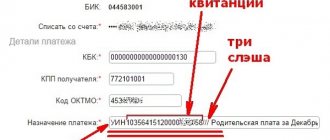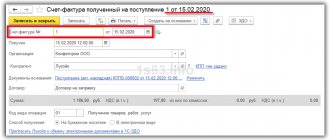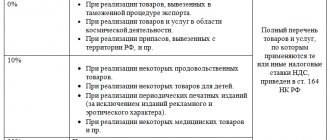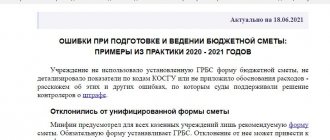How does KBK stand for?
KBK - budget classification codes
The organizations' BCCs, which are necessary for the payment to go where it was intended, change almost every year. And the responsibility for their correct indication lies with the payer!
Let's try to figure out what these mysterious codes are, why they are needed, how they are formed and why they change regularly. We will also tell you what to do if you find an error in the specified code, and what you risk in this case, and most importantly, how to prevent this risk and not end up with accrued fines and penalties for paying taxes and fees on time.
Where to find out and how to apply
The Federal Tax Service has repeatedly explained what the KBK is when paying taxes - the code by which payments must be sent so that they go to the desired item. The encoding does not depend on the region; this detail is the same for the entire country. To indicate the encoding for mutual settlements with the budget, a special field is provided in the payment order - 104.
Find out information for the details in the special reference section of our portal - Budget Classification Codes (BCC) 2022.
The most popular encodings:
| Payment type | KBK |
| simplified taxation system income 6% | 182 1 0500 110 |
| simplified tax system income minus expenses 15% | 182 1 0500 110 |
| Insurance contributions for pension insurance in the Pension Fund for individual entrepreneurs for themselves | 182 1 0210 160 |
| Insurance contributions to the Pension Fund for employees | 182 1 0210 160 |
| Unified agricultural tax | 182 1 0500 110 |
| VAT on goods sold in the Russian Federation | 182 1 0300 110 |
| Personal income tax for employees | 182 1 0100 110 |
| Income tax credited to the federal budget | 182 1 0100 110 |
| Profit tax credited to the budgets of constituent entities of the Russian Federation | 182 1 0100 110 |
| Transport tax for individuals | 182 1 0600 110 |
| Water tax | 182 1 0700 110 |
| State duty when applying to courts of general jurisdiction | 182 1 0850 110 |
| State duty paid on the basis of judicial acts based on the results of consideration of cases on the merits | 182 1 0860 110 |
There are no instructions on how to find out the BCC by TIN - the TIN of an organization, individual entrepreneur or individual is in no way connected with the budget coding. Check the code in payment receipts, in contracts with counterparties (in the payment details section), at the tax office, in special reference books (annual publications of current data), at the bank. On many online services, the encoding is filled in automatically.
Current list of KBK for 2022
KBC for paying insurance premiums for individual entrepreneurs for themselves
KBK for payment of insurance premiums for employees
BCC for payment of simplified tax system
KBK for payment of UTII
BCC for payment of unified agricultural tax
KBK for VAT payment
KBK for personal income tax payment
KBK for payment of income tax
BCC for patent payment for individual entrepreneurs
KBK for payment of trade tax
KBK for payment of transport tax
KBK for payment of property tax
KBK for payment of land tax
KBK for payment of water tax
KBK for payment of mineral extraction tax
KBK for payment of state duty
KBC for payment of fees
KBK for payment of excise taxes
KBC for payment of monetary penalties (fines)
KBK for payment of other payments
How to find out the KBK code?
You can find out the sequence of writing the numbers of the required code:
- in a special directory;
- on the website of the relevant government agency - Federal Tax Service, etc.;
- at the tax office;
- in the order of the Ministry of Finance of the Russian Federation No. 65n.
A 20-digit entry requires extreme care, so you should not fill out the necessary KBK payment details from memory.
An error in writing even one number will divert funds to another part of the budget or leave them as unidentified payments. Ultimately, arrears may arise on mandatory government payments and penalties will follow.
If you make a mistake in writing the details, you need to urgently take measures to find the incorrectly sent payment. Then write a request for a refund. If the tax codes on your payment slip are mixed up, you can contact the tax service with a request to offset payments.
Budget classification - what is it and why?
In July 1998, the Budget Code of the Russian Federation in Federal Law No. 145 first introduced the term “KBK”, used as a means of grouping the budget.
There are 4 types of KBK:
- relating to government revenues;
- related to expenses;
- indicating the sources from which the budget deficit is financed;
- reflecting government operations.
What are KBKs used for?
- organize financial reporting;
- provide a unified form of budget financial information;
- help regulate financial flows at the state level;
- with their help, the municipal and federal budget is drawn up and implemented;
- allow you to compare the dynamics of income and expenses in the desired period;
- inform about the current situation in the state treasury.
INFORMATION FOR ENTREPRENEURS! KBK is an internal coding necessary, first of all, for the state treasury, where the distribution of incoming funds takes place. Entrepreneurs need these codes insofar as they are interested in complying with the requirements for processing government payments, especially taxes and contributions to extra-budgetary funds. Therefore, do not forget to indicate the correct and current KBK code in field 104 of the payment receipt.
What is KBC?
BCC, or budget classification code, is the main digital identifier of the source of income or expenditure of the state budget of the Russian Federation and a number of other countries.
Thus, there are 2 main types of CBC:
- classifying state budget revenues;
- classifying budget expenses.
But in the practice of Russian accountants, the term “budget classification code” is most often used in the context of the 1st category, that is, budget revenues. This is quite logical: accountants are directly involved in replenishing the state treasury by directing taxes and fees there.
For the first time, the concept of the BCC in relation to budget revenues was enshrined at the legislative level in the provisions of the Budget Code of the Russian Federation (as amended on December 23, 2004). Then the term “receipt administrator code” appeared in the BC RF. Subsequently, in the process of lawmaking, it was transformed into an income classification code, and then into a budget classification code.
According to the idea of the Russian legislator, each receipt of funds into the treasury should be accompanied by an information message, according to which the departments that received the funds are obliged to distribute them. KBK is intended to be such an information message. The legislator requires taxpayers to indicate the budget classification code in payment orders for the transfer of taxes and fees.
Russian-style KBK is 20-digit. A little later we will look at its structure in detail.
Structure of the KBK
This code consists of 20 characters - numbers, separated by hyphens into groups, it has the following form XX - X XX XX XXX XX - XXXX - XXX.
Each group of characters corresponds to an encrypted meaning determined by the Ministry of Finance. Let's consider the structure of the profitable BCC, since they are the ones that entrepreneurs mainly have to use (expense codes can be found mainly when returning funds under any government program).
- "Administrator" . The first three signs show who will receive the funds and is responsible for replenishing this or that part of the budget with them, and manages the received money. The most common codes for businessmen begin with 182 - tax authority, 392 - Pension Fund, 393 - Social Insurance Fund and others.
- "Type of income" includes signs from 4 to 13. This group of signs helps to fairly accurately identify receipts based on the following indicators:
- group – 4th character (that is, the first in this paragraph);
- subgroup – 5th and 6th characters; a two-digit code indicates a specific tax, duty, contribution, fine, etc.;
- article – category 7 and 8 (the value of the purpose of the received income is encoded in the settlement documents for the budget of the Russian Federation);
- subarticle – 9, 10 and 11 characters (specifies the item of income);
- element - 12 and 13 digits, characterizes the budget level - from federal 01, municipal 05 to specific budgets of the Pension Fund - 06, Social Insurance Fund - 07, etc. Code 10 indicates the settlement budget.
- “Program” - positions from 14 to 17. These numbers are designed to differentiate taxes (their code is 1000) from penalties, interest (2000), penalties (3000) and other payments (4000).
- “Economic classification” – last three digits. They identify revenues in terms of their economic type. For example, 110 speaks of tax revenues, 130 - from the provision of services, 140 - funds forcibly seized, etc.
IMPORTANT INFORMATION! The 20-digit code must be entered correctly and without errors in the “Purpose of payment” field (field No. 104) of the payment order. In fact, it duplicates the information indicated in the “Base of payment” field, as well as partially in the “Recipient” and “Recipient’s current account” fields.
What is OKTMO
This abbreviation stands for All-Russian Classifier of Municipal Territories. OKTMO shows which subject of our country the legal entity belongs to. This detail, indicated in the declarations, is important for Rosstat. This is how the organization determines, for example, the volume of financial revenues for municipalities. This data is then used in budget planning. OKTMO approved by order of Rostandart dated June 14, 2013 No. 159-st.
The code may consist of 8 or 11 digits, which indicate the following:
- 1 and 2 digits are a subject of the Russian Federation;
- 3,4,5 symbols - district, district or intracity formations of some constituent entities of the country (Sevastopol, St. Petersburg, Moscow);
- 6,7,8 signs – rural or urban settlement, intra-city areas;
- 9,10,11 numbers are intended for objects that are part of municipal entities (for example, an 11-digit code is provided for the village of Zhukovka, which is considered an integral part of Moscow).
In tax returns, 11 cells are always allocated for OKTMO. If your code consists of 8 digits, you need to fill in 8 cells from left to right, and put a dash in the remaining three. Writing zeros in empty cells is a gross violation
(letter of the Federal Treasury for the Moscow Region and the Ministry of Finance of the Moscow Region dated 02/03/14 No. 48-12-13/02-728 and No. 22ish-693/22-07-02).
Why are budget classification codes changing?
This is the cry from the heart of the vast majority of entrepreneurs: how much easier it would be if these codes were uniform and established once and for all. But the Ministry of Finance makes certain changes to the BCC almost every year. Entrepreneurs and accountants do not always have the opportunity to timely monitor innovations and correct the specified BACs, this is especially evident during reporting periods. Responsibility for incorrectly specified code lies entirely on the shoulders of businessmen, which often results in unexpected expenses and hassle in correcting the error and proving that they are right.
There are various versions put forward by entrepreneurs and the Ministry of Finance and the Ministry of Justice do not comment in any way.
- The more receipts passed through incorrect BCCs, the more funds will be “suspended” for some time as unknown. Until errors are corrected, they can be used for unseemly purposes, and on a national scale this is a huge amount.
- Additional filling of the budget by charging fines and penalties for “overdue” payments that were made through the already inactive BCC. Proving timely payment is quite troublesome.
- Inconsistency between the actions of the Ministry of Finance, which assigns codes, and the Ministry of Justice, which approves them.
- Since the KBK is directly “tied” to the public sector, any changes within the relevant structures, the receipt of new directives, etc. lead to a change in coding.
FOR YOUR INFORMATION! There are opinions that since this coding is an internal matter of the Treasury, it should be done by them, and not by taxpayers. The KBK code can be assigned by bank employees based on the specified data about the recipient and purpose of the payment, or by treasury employees upon receipt of it. However, today the additional work of coding is placed on the shoulders of payers; they cannot avoid it, which means that all that remains is to comply with the current requirements and keep abreast of the latest innovations.
Arbitration practice: old or incorrect BCC for tax - there will be no penalties
An interesting precedent involving the taxpayer and the Federal Tax Service, which assessed penalties for taxes paid under the outdated BCC, that is, once included in the list of the Ministry of Finance, but subsequently replaced by another.
In the resolution of the Federal Antimonopoly Service of the Central District dated October 8, 2013 in case No. A14-18051/2012, the court considered the claim of an entrepreneur who paid the simplified tax system in 2011 under the old BCC. The Federal Tax Service considered this a violation of the individual entrepreneur’s obligation to transfer taxes, recorded the arrears and assessed penalties. Subsequently, the Federal Tax Service counted the payments that ended up in the department’s accounts under the erroneous BCC against current taxes, but sent the individual entrepreneur a request to pay penalties.
The court in three instances declared the actions of the Federal Tax Service illegal and annulled the penalties. The arbitration found that, in accordance with the provisions of Art. 45 of the Tax Code of the Russian Federation (as amended, relevant for the period under review), the payer’s obligation to transfer tax to the treasury is considered unfulfilled only if the payment order contains incorrect details of the Federal Treasury and the name of the recipient’s bank. The cassation, in particular, indicated that the entrepreneur’s incorrect indication of the KBK cannot be a reason to consider him as having evaded paying tax, since the corresponding amount was transferred to the budget system of the Russian Federation.
In a similar situation, the Moscow District Arbitration Court issued a ruling in favor of the taxpayer dated May 23, 2016 No. F05-6154/2016 in case No. A40-168537/2015 regarding payment for a patent made by an individual entrepreneur on time, but according to an incorrectly specified BCC. The Federal Tax Service considered that the deadline for payment should be the date of filing the application to clarify the details, which went beyond the period allotted for paying for the patent, but several courts did not support this position.
Similar conclusions are also found in the decisions of the Volga District Court of Justice dated 06/06/2018 in case No. A65-32834/2017, the Volga-Vyatka District Court of Justice dated 01/24/2018 in case No. A82-5449/2017, etc.
Thus, if in the payment order, instead of the 2022 BCC, the company indicated an outdated or incorrect one, then it is possible to prove that the tax was paid and there is no tax arrears, relying on the decision in the above-mentioned arbitration case. An additional argument in defense of the taxpayer in the event of incorrect application of the BCC in 2022 can also be letters from the Ministry of Finance dated January 19, 2017 No. 03-02-07/1/2145, dated July 17, 2013 No. 03-02-07/2/27977 and dated March 29 .2012 No. 03-02-08/31, Federal Tax Service dated 10.10.2016 No. SA-4-7/ [email protected]
What are the consequences of an error in the KBK?
If the payment purpose code is specified incorrectly, the payment will be transferred to the budget, but it will not be distributed correctly there, which means that the state will not actually receive it. The result may be the same as if the money had not been transferred at all: the tax office will count the arrears under a certain item. At the same time, if the BCC is simply mixed up, there may be an overpayment under another item.
As a result, the tax office will issue a demand for payment of arrears, a fine for late payment of tax or a fee and penalties for late payment. This situation is extremely unpleasant for a conscientious entrepreneur who paid the tax on time, whose entire fault lies in confusion with numerous CBCs.
The usual procedure for an entrepreneur when an error is detected in the KBK
- The most important thing is to make sure that the error did not lead to non-receipt of income to the budget, otherwise it will be considered that the funds were not paid, with the payer being fully responsible for this.
- Submit to your tax accounting office a statement about the detected error and a request to clarify the basis, type and affiliation of the transfer of funds, if necessary, the tax period or tax payer status.
- The application must be accompanied by payment orders for which the tax was paid and received by the budget.
- If necessary, a reconciliation of paid taxes is carried out jointly with the inspector (a report is drawn up about it).
- After a few days (the period is not defined by law), a decision is made to clarify this payment and is handed over to the applicant.
IMPORTANT! When a payment is clarified, it is considered completed on the day the payment order is submitted with an incorrect BCC, and not on the day the decision on clarification and offset is received. Thus, the delay in mandatory payment, which provides for penalties, does not actually occur.
Let's look at various cases that occur due to errors in the CBC and analyze what an entrepreneur should do.
- The inspectorate assessed penalties for non-payment of taxes . If there was a beneficial request from the payer to offset the amount paid, then you should additionally ask the tax office to recalculate the accrued penalties. If the tax office refuses to do this, going to court will most likely allow for a recalculation (there is a rich case law with similar precedents).
- The BCC does not correspond to the payment specified in the assignment . If the error is “within one tax”, for example, the KBK is indicated on the USN-6, and the payment basis is indicated on the USN-15, then the tax office usually easily makes a re-offset. If the KBK does not completely correspond to the basis of the payment, for example, a businessman was going to pay personal income tax, but indicated the KBK belonging to the VAT, the tax office often refuses to clarify, but the court is almost always on the side of the taxpayer.
- Due to an error in the KBK, insurance premiums were unpaid . If the funds do not reach the required treasury account, this is almost inevitably fraught with fines and penalties. The entrepreneur should repeat the payment as quickly as possible with the correct details in order to reduce the amount of possible penalties. Then the money paid by mistake must be returned (you can also count it against future payments). To do this, an application is sent to the authority to whose account the money was transferred erroneously. Failure to comply with a request for a refund or re-credit is a reason to go to court.
- The funds entered the planned fund, but under the wrong heading . For example, the payment slip indicated the KBK for the funded portion of the pension, but they intended to pay for the insurance portion. In such cases, contributions are still considered to have been made on time, and you must proceed in the same way as under the usual procedure. The court can help with any problems with a fund that refuses to make a recalculation, and an illegal demand for payment of arrears and the accrual of penalties.
REMEMBER! According to the law, an error in the KBK is not a reason for which the payment will not be considered transferred. The payment order contains additional information indicating the purpose of the payment and its recipient, therefore, if it is indicated correctly, there is and cannot be a reason for penalties against the entrepreneur; other decisions can be challenged in court.
In what cases does the KBK predetermine the classification of a payment as unclear?
One of the criteria for classifying a payment as unclear is the absence of a KBK in the payment order, an indication of an incorrect or ineffective KBK (Order of the Federal Treasury dated May 14, 2020 No. 21n). It is assumed that the responsibility for indicating the correct BCC rests entirely with the taxpayer, since the BCC data is published in regulations. If the company indicated an incorrect BCC, as a result of which the payment did not reach its destination, it is advisable to send an application to the Federal Tax Service to clarify the payment (clause 7 of Article 45 of the Tax Code of the Russian Federation).
For information on how to fill out such an application, read the article “Sample application for clarification of tax payment (error in the KBK)” .
If you do not pay your tax on time, the Federal Tax Service will charge a penalty. The BCC for the payment of penalties differs from the BCC for the payment of taxes and contributions. ConsultantPlus experts explained what codes need to be indicated when transferring penalties. To do everything correctly, get trial access to the system and go to the Ready solution. It's free.
It will be useful to consider what legal consequences, in principle, could result from an incorrect indication by the taxpayer in the KBK payment order in 2022.
Code structure
The structure of the KBK indicator cannot change; changes are made only to groups of numbers.
6 groups of numbers that determine the addressee, purpose of payment, etc.:
- The first 3 digits: Pension Fund – 392, Federal Tax Service – 182, Social Insurance Fund – 393.
- Fourth digit: “1” means income, “2” means gratuitous payments.
- Fifth and sixth digits: 01 – personal income tax, 06 – property tax, 08 – state duty.
- The twelfth and thirteenth digits indicate the budget level: 01 - federal, 02 - regional, 03, 04, 05 - municipal, 06 - Pension Fund, 07 - Social Insurance Fund.
- From the fourteenth to seventeenth digits the basis is determined: 1000 - taxes and fees, 2000 - penalties, 3000 - fines.
- From the eighteenth to the twentieth digits the income type is determined: 110 – taxes, 130 – payment for services rendered, 150 – gratuitous receipts.
How to fix the error?
For employees of budgetary organizations, the KBK is an important working tool that simplifies the process of identifying payments and helps to quickly and correctly distribute funds received into government accounts. Therefore, the speed of crediting funds to the required account depends on the correctness of filling out the payment document.
Reference!
If the payer made an error in the code, then the money may return to his account, get stuck in “unclear payments” or be credited to an incorrect account. This is fraught with fines and penalties, since they were not on the correct account on the deadline date. It is important to double check the relevance of the KBK before sending!
The most common mistakes that accountants and individuals make when transferring funds:
- indication of an incorrect BCC applicable for another payment;
- error in one or more KBK digits.
To ensure that the money ends up in the correct account, they write an application addressed to the Federal Tax Service of the Russian Federation and indicate in it the correct details and BCC. The IRS will grant such requests and often indicate the date the funds were credited to the correct account as the date of the original payment.
Three simple steps to fix the error
- An application is sent to the tax authority indicating the error, as well as the correct code. It is written in free form, and a copy of the payment document with the bank’s seal is attached to it.
- Within 10 days a decision is made and the error is eliminated.
- Once the error has been corrected, a reconciliation report should be ordered to confirm that funds have been redirected to the correct account.
Since the KBK belongs to the group of details that allow one to determine the identity of the payment, if an erroneously specified KBK is detected in the order for the transfer of tax, the payer has the right to contact the tax authority with an application to clarify the identity of the payment.








